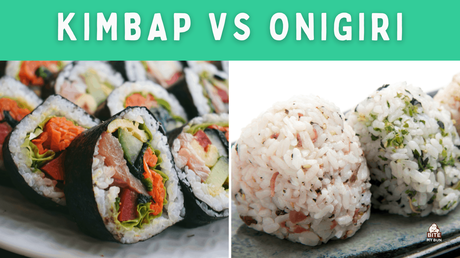There is no doubt that Korean kimbap and Japanese onigiri are two of the world’s tastiest rice dishes. Both are a kitchen staple, easy to make, and can fit on small containers.
Since both rice dishes have fillings inside and wrapped in nori, someone who isn’t familiar might mistake the one for the other.

Kimbap and onigiri are two rice dishes known for their simplicity and convenience. Onigiri is more of a sandwich-type meal; it doesn’t have to get sliced and dipped. On the other hand, kimbap needs to be cut sushi-style and usually has two or more fillings. Nori helps kimbap stay in shape, while onigiri uses it as a holding wrap.
The differences between kimbap and onigiri
From the outset, some elements of kimbap and onigiri are very similar. The star of the show in both dishes is the filling inside the rice.
But there are a few things that separate a kimbap from an onigiri, and luckily, these are easy to spot.
Nori
Nori or dried seaweed sheets are both featured in both dishes.
In onigiri, the small green sheet is often used as a moisture barrier between the eater’s hand and the rice. It serves more as a functional barrier than an irreplaceable ingredient.
Meanwhile, the dried seaweed sheet in kimbap is for keeping each piece in its circular shape. It also helps give a compact form factor so that Korean parents can add more food in a dosirak.
Rice shape
When it comes to its shaping, a lot of people will find onigiri harder to make. Each ball of onigiri will need to be shaped manually in either a spherical, cylindrical, or triangular shape.
The size is up to you, but the bigger your onigiri is, the harder it would be to maintain the shape.
Kimbap is sliced into tiny bite-sized pieces like sushi. The process can be made easier by using a bamboo mat while rolling the rice and the ingredients.
Hence, you can have more pieces of food to share with other people.
Seasoning
Unlike sushi or kimbap, the rice in an onigiri serving is not seasoned. A plain steamed Japanese rice is used to create this dish; no salt, no vinegar, no sugar.
Some would sprinkle a few toasted sesame seeds or rice seasoning (furikake) for more taste, but this is optional.
On the other hand, you need to prepare a bit of salt, sugar, and vinegar to season kimbap. Traditionally, you can also add sesame oil to the mix for a flavor boost.
Sesame oil also adds a new texture to the rice, which makes the experience more enjoyable.
Fillings
The cook can add anything to an onigiri, which is why it is very versatile. Home-made onigiri is often more resourceful by using leftovers from the previous dinner.
One thing to remember: traditional onigiri fillings are usually savory and use cooked or flavored food, although if you like you can also make onigiri sweet.
Kimbap usually has vegetables in its fillings, especially carrots, spinach, and yellow pickled radish. Adding fish cakes and fried egg is also a popular option for quick-made kimbap rolls.
Most fillings are stuffed in the middle and pressed together during the bamboo mat rolling.
Eating
Onigiri is like sandwiches; you often pack them in a handy container and eat them on the go. The reason for this is because most onigiri servings are enough for a decently sized meal.
Adding onigiri in a bento box is also a popular practice. It doesn’t need a chopstick or any cutlery because the nori wrapping prevents direct contact with the food.
Kimbap is a common sight in every student’s dosirak. It often serves as a side dish, along with a complete meal.
One of the reasons why it is served sliced is for friends or family to share while eating. You can see this dish served on picnics as a boon-shik, or a casual snack.
Also learn how sushi compares to kimbap
What makes both onigiri and kimbap popular?
Now that we know the differences between the onigiri and kimbap, let’s talk about the reasons why they are popular.
Portable and convenient
Both onigiri and kimbap have a compact form factor. You can pack both in a bento or dosirak, in addition to other food items.
It is a heaven-sent recipe for those who need to travel and eat on the go. Most convenient stores often sell pre-made onigiri and kimbap.
Easy to prepare
You might have a bit of difficulty during the first time trying both recipes. But once you get the hang of it, preparing onigiri or kimbap is very easy.
In addition, you can use almost any ingredients available to you (as long as the flavor works, of course.)
Healthier than most snacks/lunch
Most fillings in both rice dishes have low caloric contents. For example, kimbap usually contains vegetables and fried eggs, which is nice for a nutritional snack.
Onigiri might have a few more calories, especially in tuna mayo filling, but you can always opt for other ones if you like.
Next, find out the Most popular Japanese konamono or “flour things” | Have you tried them all?
